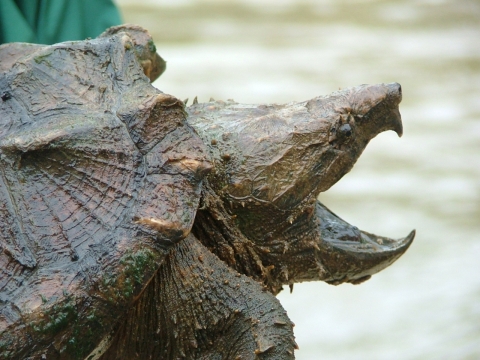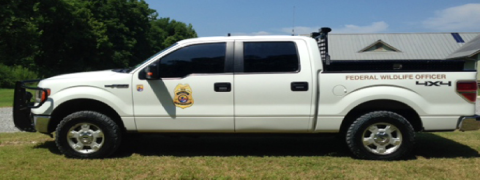What We Do
Resource Management
Habitat management programs are implemented to meet conservation objectives for migratory and resident wildlife, as well as native plant communities.
When compared with the eight other Refuges in the Complex, Panther Swamp National Wildlife Refuge lies at the lowest elevation (75 to 100 feet mean sea level). As a result, habitat management is challenged by regular flood events-, and wet conditions throughout most of the year. Habitat management programs are implemented to meet conservation objectives for migratory and resident wildlife as well as native plant communities. Forest management includes selective harvesting to ensure a healthy, viable forest. Reforestation on marginally productive croplands is common. Refuge croplands are managed to provide diverse habitat types and “hot” foods for migratory waterfowl.
Seasonally flooded impoundments, or moist-soil units, provide feeding and resting areas for waterfowl and shorebirds, while acting as “filters” to improve surface and groundwater quality. Public hunting for various game species helps manage wildlife populations at healthy levels and provides excellent recreational opportunities.
The Corps of Engineers (COE) owns 7,067 acres within the acquisition boundary of the Refuge, primarily in the Big Twist Mitigation Area. These lands were set aside as bottomland hardwood forest mitigation for the COE Upper Yazoo Basin Project, and as such the entire tract must be maintained in bottomland hardwood habitat. A long-term agreement between the COE and Fish & Wildlife Service assigns the Fish & Wildlife Service with management responsibilities for the area.
Trapping Occurs on this Refuge
Trapping is a wildlife management tool used on some national wildlife Refuges. Trapping may be used to protect endangered and threatened species or migratory birds or to control certain wildlife populations. The U.S. Fish and Wildlife Service also views trapping as a legitimate recreational and economic activity when there are harvestable surpluses of fur-bearing mammals. Outside of Alaska, Refuges that permit trapping as a recreational use may require trappers to obtain a Refuge special use permit. Signs are posted on Refuges where trapping occurs. Contact the Refuge manager for specific regulations. Click here for more information on trapping within the National Wildlife Refuge System.
Conservation
Comprehensive Conservation Plan
Refuge conservation plans are called “comprehensive conservation plans” (CCPs). The purpose of a CCP is to specify a management direction for the Refuge for the next 15 years. The goals, objectives, and strategies for improving Refuge conditions—including the types of habitat we will provide, partnership opportunities, and management actions needed to achieve desired conditions – are described in the CCP. The Service’s preferred alternative for managing the Refuge and its effects on the human environment, are described in the CCP as well. Our CCP is available only by request, please email TRNWRComplex@fws.gov if you would like a copy.
Moist Soil Units
In order to provide quality waterfowl habitat, Refuge management activities focus on the availability of food resources, habitat diversity and providing sanctuary. Moist soil units are one of the more common habitat types managed to provide ducks and other migratory birds with necessary feeding and resting areas.
Croplands
Croplands are managed using a cooperative farming program. Under this program, a local farmer has an agreement with the Refuge so that he can farm on Refuge land. In return for the use of the land, the farmer must plant and leave 25% of the crop for wildlife. Typically, corn, soybeans, milo, and wheat are planted on a rotational basis. These cropland areas are excellent for wildlife viewing, offering excellent opportunities to see white-tailed deer, Louisiana black bear, and waterfowl during the winter months.
Management and Conservation
Our Projects and Research
MSU Black Bear Genetic Structure and Dietary Components
Hair samples are collected via hair snare corrals, made of strands of barbed wire. Hair samples are necessary for both DNA extraction for genetic analysis and stable isotope analysis to investigate diet. These corrals are checked biweekly over 6 weeks. The corrals were set up May to June, sampling continued through July, and equipment removed in August. Camera traps were deployed to assess black bear activity at other sites. Potential food items were collected. These included arthropods, berries, tree fruit, grasses/sedges, vines, herbaceous vegetation, road-killed vertebrates, and fish.
USM Distribution and Relative Abundance of Alligator Snapping Turtle
The alligator snapping turtle is a candidate species for federal protection under the Endangered Species Act. Surveys are being conducted throughout their range with direction from USFWS for the species status assessment. Very little is known about the distribution, abundance and demographics of the alligator snapping turtle. Surveys are being conducted throughout all Mississippi major river drainages. All freshwater turtle species captured were marked, measured, tissue sample acquired, and released at the location of capture. Habitats sampled include navigable rivers and oxbow lakes.
Law Enforcement
The primary purpose for America’s National Wildlife Refuges is protecting and managing habitat and species, and other natural resources. Refuge Law Enforcement plays a vital role in fulfilling this mission, as well as providing a safe environment for people utilizing the Refuge.
Refuge Officers ensure that wildlife, plants, and other natural resources on our National Wildlife Refuges are protected for the benefit of present and future generations of all people. Refuge Officers receive extensive training in both standard police operations and the highly specialized field of wildlife law enforcement. Refuge Officers work closely with the Mississippi Department of Wildlife, Fisheries and Parks to enforce Federal laws such as the Migratory Bird Treaty Act, Refuge Administration Act, Refuge Recreation Act, and the Endangered Species Act, as well as all pertinent state wildlife laws and regulations.
See the current Complex Public Use Regulations for more information.



